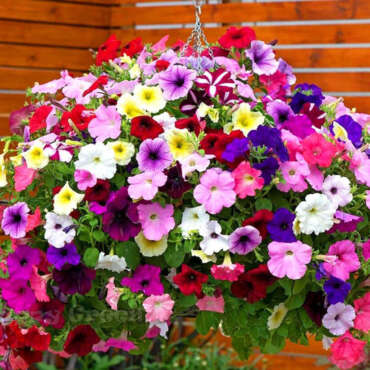Product Description
Petunia | 11″ – Hanging Baskets – Mix
Today, there are even more reasons to fall in love with them because there are so many more choices. From compact types with dime-size blooms to spreading or trailing varieties that reach to 4 feet, they now come in a wide variety of colors, sizes, petal profiles, and growth habits. This new-generation has also been bred to outperform their predecessors, producing nonstop blooms all summer long on sturdier, easy-to-grow plants.
BASICS
Are petunias perennials or annuals?
Although they are actually classified as tender perennials, they won’t tolerate frost so they are commonly grown as annuals in most climates.
Sun or shade?
Full sun
Bloom time:
Summer
Color and characteristics:
You can find them in just about any color, even black, as well as striped, veined, and speckled patterns. The variety of flower forms is also impressive, ranging from petite to palm-sized in single or double blooms with ruffled, fringed, or smooth edges.
HOW TO PLANT PETUNIAS
When to plant:
In spring, after the threat of frost has passed.
Where to plant:
For the best performance, plant in full sun (at least six hours a day). They will tolerate some shade, but may not flower as prolifically.
Soil:
They grow best in a light, fertile soil that provides good drainage and is slightly acidic (pH 6 to 6.5). In heavy clay soils, work some compost, or other organic matter into the ground before planting. When planting in containers, use a free-draining soilless potting mix fortified with a slow-release fertilizer.
Grow petunias from seed:
You can also grow many types from seed if you’re after a certain variety not available as a transplant. Because petunia seeds are very tiny and slow to germinate, you’ll have better success starting the seeds indoors 8 to 10 weeks before the last frost date in your area and transplanting the seedlings into the garden once the soil warms up.
PETUNIA CARE
Water:
Petunias need regular watering because their shallow root systems dry out quickly. However, make sure the soil is well drained because soggy soil can cause root rot and yellowed foliage. Petunias grown in containers may need more frequent watering, possibly every day, especially in hot weather.
Fertilizing:
To keep petunias blooming vigorously throughout the summer, apply a monthly dose of liquid fertilizer or a slow-release granular fertilizer at the time of planting. Plants in containers often need more frequent fertilizing because the nutrients get washed out.
Pruning and deadheading:
The amount of pruning required often depends on the variety you’re growing.
- Traditional grandifloras require the most work and need frequent deadheading to prevent plants from going to seed.
- Self-cleaning and spreading varieties do fine without pinching or pruning. Occasional deadheading will boost flower production and create fuller plants.
- If your plants begin to get leggy and have fewer blooms, cutting them back will encourage new growth and more branching.
Pests and diseases:
Petunias can be bothered by pests like aphids, thrips, mites, caterpillars and budworms; as well as powdery mildew.
Information from www.gardendesign.com
Specifications
- Weight: 15 lb
- >>: Colors are approximate

